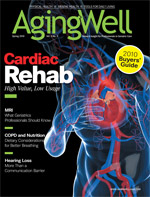Spring 2010 Invisible Epidemic If medication nonadherence were a disease, it would be an epidemic. Every day, patients fail to pick up prescriptions from the pharmacy, inadvertently skip scheduled doses, take medications incorrectly, or simply stop taking them altogether. Adherence rates are suboptimal even among healthcare providers who presumably are knowledgeable about the benefits of appropriate medication use. These circumstances seriously undermine patient outcomes, quality of life, quality of care, and the value of healthcare dollars spent. Although age is not necessarily a determining factor in medication nonadherence, the older adult population is at high risk for medication misadventures. The most common estimate of medication nonadherence in the general population is 50%; a range of 26% to 60% has been reported for older adults.1-3 Among Medicare beneficiaries, approximately 90% take prescription medications. Of these, 50% use five or more different medications, and 55% do not follow their treatment regimens as prescribed.4 What Is Medication Nonadherence? Medication nonadherence, either willful or inadvertent, can include the following: • omitting one or multiple doses; • taking more medication than was prescribed; • prematurely discontinuing medication; • taking a dose at an incorrect time; • taking medication prescribed for someone else; • taking medications with prohibited foods, liquids, or other medications; • taking medications that are expired, damaged, or stored improperly; or • improperly using medication devices (eg, inhalers, syringes). Contributing Factors The WHO has determined the following five distinct categories (termed dimensions) to describe the interplay of factors reported to affect adherence: 1. social and economic factors (eg, low health literacy, medication cost, unstable living conditions); 2. healthcare system factors (eg, provider-patient relationship, provider communication skills, no care continuity); 3. condition-related factors (eg, chronic conditions, lack of symptoms, psychiatric disorders); 4. therapy-related factors (eg, complexity of medication regimen, duration of therapy, medications with social stigma attached to use); and 5. patient-related factors (eg, visual impairment, cognitive impairment, psychosocial stress, anxiety, anger). Depression, which is common among older adults, is one example of a condition-related factor that is often associated with poor medication adherence for numerous reasons. It may take four weeks or more for antidepressants to reach their full therapeutic effect. Meanwhile, side effects are most likely to occur early in therapy prior to symptom relief. This may lead to premature discontinuation if the patient perceives the treatment risks to outweigh any potential benefits. Patients may also discontinue antidepressant therapy once they begin to feel better, placing them at an increased risk for relapse. Consequences Among older adults, the consequences of medication nonadherence may be more serious and less easily detected compared with younger age groups. Medication nonadherence accounts for more than 10% of older adult hospital admissions5, nearly 25% of nursing home admissions6, and 20% of preventable adverse drug events in the community setting.7 Overcoming Barriers When suboptimal adherence is identified, healthcare providers should work with patients to identify the cause(s) and develop a strategy for improvement. Interventions should be initiated early in the treatment process and must include follow-up. It should be noted that adherence interventions must be customized to meet each individual patient’s needs. For example, if a patient frequently skips medication doses because of cost, providing that patient with a pillbox to organize the medications will not likely resolve the issue. The WHO has proposed a foundational model for improving medication adherence based on three factors: information, motivation, and self-efficacy. Information is a prerequisite for behavior change and includes basic knowledge about the medical condition. Motivation encompasses personal attitudes toward the adherence behavior, perceived social support, and perceptions of how others may behave. Self-efficacy describes the patient’s belief or confidence in his or her ability to carry out a target behavior and the extent to which the behavior is actually carried out correctly. Interventions based on this model have been effective in facilitating behavior change. Information and motivation work largely through behavioral skills (self-efficacy) to affect behavior. Measuring a patient’s willingness or readiness to change and the level of his or her social support determines the motivation. Self-efficacy includes ensuring that the patient has the specific behavioral tools or strategies necessary to perform an adherence behavior. When the behavioral skills are familiar or uncomplicated, information and motivation can have direct effects on behavior. Conclusion Levine demonstrated that the following steps increase adherence8: • tying the medication-taking process to other daily routines; • using adherence aids, such as medication organizers or charts; • simplifying medication regimens; • providing personal support from within the healthcare team; and • recognizing difficulty in coping and other sociobehavioral issues that may affect the patient’s ability to follow the treatment regimen. — Julie Testman, PharmD, BCPS, CGP, is an assistant professor of pharmacy practice at the University of Charleston School of Pharmacy in West Virginia.
References 2. McGraw C, Drennan V. Older people and medication management: From compliance to concordance. Rev Clin Gerontol. 2004;14(2):145-153. 3. Balkrishnan R. Predictors of medication adherence in the elderly. Clin Ther. 1998;20(4):764-771. 4. Amaral P. The special case of compliance in the elderly. In: Gerber KE, Nehemkis AM (eds). Compliance: The Dilemma of the Chronically Ill. New York: Springer; 1986. 5. Vermeire E, Hearnshaw H, Van Royen P, Denekens J. Patient adherence to treatment: Three decades of research. A comprehensive review. J Clin Pharm Ther. 2001;26(5):331-342. 6. Strandberg LR. Drugs as a reason for nursing home admissions. J Am Health Care Assoc. 1984;10(4):20-23. 7. Gurwitz JH, Field TS, Harrold LR, et al. Incidence and preventability of adverse drug events among older persons in the ambulatory setting. JAMA. 2003;289(9):1107-1116. 8. Levine AM. Antiretroviral therapy: Adherence. Clin Care Options HIV. 1998;4:1-10. |

